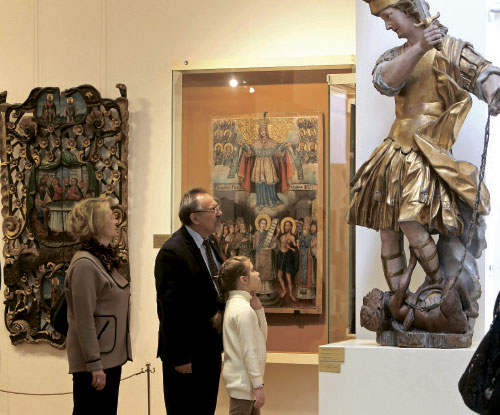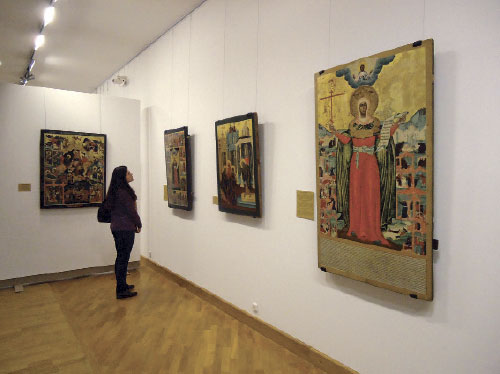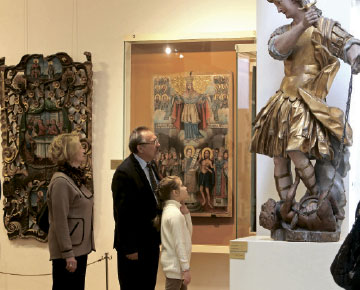
Exhibition at the National Art Museum
Local tastes shaped the direction of the icon-painting school since merchants often paid for artworks, for donation to their church, and the best artists from across the Russian empire were attracted for such work: from Veliky Ustyug, Novgorod, Moscow and Kostroma. Such masters as Fiodor Zubov, Guriy Nikitin and Semen Spiridonov created icons for the city. Meanwhile, the local artistic environment also thrived; secular icon painting, portraying a more ‘realistic’ and original view of the world, became popular. The 37 icons on show are notable for their bright, festive atmosphere, with lively figures and greatly ornamented costumes, often using gold and silver. Probably, the refined icon painters of Stroganov influenced the style.
The second exhibition, entitled Christianity and Christians in Creative Activity of Russian and Belarusian Artists of the Middle 19th-Early 20th Century, comprises icons and other paintings, as well as sculpture, from the National Art Museum. Its collection of Russian art is one of its most significant, with the religious theme taking a worthy place. On show are 29 works.
Portraiture was a key element of contemporary Christian art, representing those who played a special role. For the first time, the portrait of Metropolitan Iosif Semashko is on display. An active figure in the reunification of the Uniats with the Orthodox Church, he was painted in 1849 by Belarusian artist Ivan Khrutsky. Other portraits include those of Goravsky and Kramskoy, Losev, Polenov, Sukhodolsky and Nesterov. The wooden sculptures of saints, restored by domestic masters, are also sure to delight visitors.

Russian art is one of the most significant among the collections of the National Art Museum, with the religious theme well represented. From the time of the foundation of the Academy of Arts in St. Petersburg, in 1757, students began creating works on Biblical themes. Classical artistic language, notable for pathos and theatricality, gestures and bright colours, is evident in such works as: The Penitent Magdalene, by Apollinary Goravsky, of the Mogilev Region; The Prayer of Moses After Crossing the Black Sea by Israel, created by Ivan Kramskoy in his student years (a later member of the itinerant movement); The Prodigal Son, by academic Nikolay Losev; and The Sacrifice of Abraham, by an unknown artist.
Unlike traditional, academic masters, these artists, with their ‘everyday’ connections, captured an element of realism that withstood the passing of time. Vasily Polenov’s Life of Christ series presents a strikingly realistic portrayal of the Palestinian landscape (he visited more than once), and some simple, composite solutions: Sitting Christ, Christ on the Sea of Galilee (Lake of Gennesaret), and Bringing of Children.
Some works show the common life of Christians: The Procession of the Cross over Water, and Hallowing in a Village by Ivan Trutnev; Nikolay Nevrev’s Confession; and Icon Meeting by Piotr Sukhodolsky. Nesterov’s creativity has an eternal feel, encapsulated in modern form.

Exhibition of sacral artworks, dedicated to 80th anniversary of Metropolitan Filaret, Honourable Patriarchal Exarch of all Belarus
The third exhibition is On Sacred Athos, by Greek artist Alexander Kayas, with 23 canvases on loan from private state collections across Europe and America. Alexander Kayas is a member of the Association of Artists of Northern Greece and of the Chamber of Fine Arts of Greece. His canvases are enjoying their first exhibition in Belarus, exploring monkhood, asceticism and deep spirituality. He shows the life of the monastic community of Athos, including paintings of the Metropolitan Filaret: more than one of his portraits is included in the exhibition. His style draws on the traditions of late 19th century Russian realistic painting. Meanwhile, Kayas’ monumental frescoes are truly impressive, as is evident from his image of Saint Demetrius.

The Metropolitan Filaret’s message, published on the official Belarusian Orthodox Church website, reads: ‘Icons are more than illustrations, embodying truths of divinity, and showing the light of the Celestial Kingdom to the whole world. Certainly, the most organic environment for an icon is a church but they serve an educational purpose in museums, silently preaching the Gospel’.
The fifth exhibition, Orthodox Belarus, has been prepared by the Ministry of Communications and Informatisation and Belpochta enterprise, displaying a selection of religiously themed stamps.
The Ministry of Information of Belarus’ special album of Orthodox icons, named Orthodox World, is devoted to the 1025th anniversary of Christianity being founded in Rus. It was published in 2013, under the patronage of the Metropolitan Filaret.
By Victor Mikhailov











